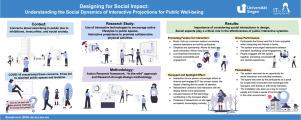为社会影响而设计:了解公共福祉的互动预测的社会动态
IF 5.1
2区 计算机科学
Q1 COMPUTER SCIENCE, CYBERNETICS
International Journal of Human-Computer Studies
Pub Date : 2025-08-27
DOI:10.1016/j.ijhcs.2025.103596
引用次数: 0
摘要
我们的研究是一项关于锻炼和健康的大型研究的一部分,主要关注公共场所中互动人工制品的使用。我们的研究结果表明,许多人由于压抑、不安全感和社交焦虑而担心在公共场合锻炼,这些都会影响到这种情况下的行为。特别是在2019冠状病毒病大流行之后,新的活动机会可以改善福祉和身体活动能力——这是期望的结果。在鼓励积极的生活方式和公共场所的流动性方面,技术创新的实施,尤其是互动技术的实施,似乎很有希望。通过对身体活动的探索,本研究揭示了在城市公共空间中使用互动投影所固有的社会方面。我们采取了一种“野外”的方法,并通过设计方法进行了公共研究。我们发现,虽然互动投射可以刺激身体活动,但有效性和接受度受到人际行为的显著影响。这样,就可以观察到不同利益相关者群体在互动空间内外的社会互动变化。这项工作强调了未来研究在交互式公共系统的设计和使用中考虑可见和不可见的社会动态的必要性。本文章由计算机程序翻译,如有差异,请以英文原文为准。

Designing for social impact: Understanding the social dynamics of interactive projections for public well-being
Our research, part of a larger study on exercise and well-being, focuses on the use of interactive artefacts in public spaces. Our findings suggest that many people have concerns about exercising in public due to inhibitions, insecurities, and social anxiety, which can affect behaviour in this context. Both well-being and physical mobility — the desired outcome — can be improved by new opportunities for activity, especially after the COVID-19 pandemic. The implementation of technological innovations, especially interactive ones, seems to be promising when it comes to encouraging active lifestyles and mobility in public places. Through its exploration of physical activity, this research unveils the social aspects inherent in the use of interactive projection in urban public spaces. We took an “in-the-wild” approach and conducted public studies using a research through design methodology. We found that while interactive projections can stimulate physical activity, effectiveness and acceptance are significantly influenced by interpersonal behaviours. Thus, changes in social interactions among different stakeholder groups could be observed both inside and outside the interaction space. This work highlights the need for future studies to consider visible and invisible social dynamics in the design and use of interactive public systems.
求助全文
通过发布文献求助,成功后即可免费获取论文全文。
去求助
来源期刊

International Journal of Human-Computer Studies
工程技术-计算机:控制论
CiteScore
11.50
自引率
5.60%
发文量
108
审稿时长
3 months
期刊介绍:
The International Journal of Human-Computer Studies publishes original research over the whole spectrum of work relevant to the theory and practice of innovative interactive systems. The journal is inherently interdisciplinary, covering research in computing, artificial intelligence, psychology, linguistics, communication, design, engineering, and social organization, which is relevant to the design, analysis, evaluation and application of innovative interactive systems. Papers at the boundaries of these disciplines are especially welcome, as it is our view that interdisciplinary approaches are needed for producing theoretical insights in this complex area and for effective deployment of innovative technologies in concrete user communities.
Research areas relevant to the journal include, but are not limited to:
• Innovative interaction techniques
• Multimodal interaction
• Speech interaction
• Graphic interaction
• Natural language interaction
• Interaction in mobile and embedded systems
• Interface design and evaluation methodologies
• Design and evaluation of innovative interactive systems
• User interface prototyping and management systems
• Ubiquitous computing
• Wearable computers
• Pervasive computing
• Affective computing
• Empirical studies of user behaviour
• Empirical studies of programming and software engineering
• Computer supported cooperative work
• Computer mediated communication
• Virtual reality
• Mixed and augmented Reality
• Intelligent user interfaces
• Presence
...
 求助内容:
求助内容: 应助结果提醒方式:
应助结果提醒方式:


